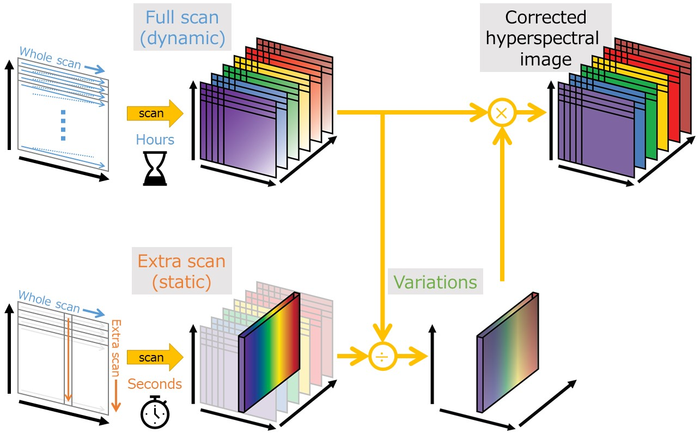While scanning cathedral stained-glass windows, scientists from the Nara Institute of Science and Technology developed a novel method to compensate for fluctuations in illumination. This technique might be extended to other culturally significant objects to help frame their colors in the most authentic way possible.
 Color compensation procedure. The whole scan takes hours to capture thousands of spectral channels, pixel by pixel. Thus, the image is affected by variations in natural illumination during the scan. The proposed approach includes an extra scan on a single column, which takes only dozens of seconds so that the illumination variation is negligible. By comparing both scans, the approach allows us to determine the variation component during the scan, and use it to compensate for the variations. Image Credit: Takuya Funatomi.
Color compensation procedure. The whole scan takes hours to capture thousands of spectral channels, pixel by pixel. Thus, the image is affected by variations in natural illumination during the scan. The proposed approach includes an extra scan on a single column, which takes only dozens of seconds so that the illumination variation is negligible. By comparing both scans, the approach allows us to determine the variation component during the scan, and use it to compensate for the variations. Image Credit: Takuya Funatomi.
It is difficult to imagine a more inspiring experience than watching the sunset through ancient stained-glass windows like those seen in European cathedrals. While the shifting light levels over time are attractive, high-resolution scans of the windows are more difficult. Variations in natural illumination might lead to uneven outcomes if the scanning process takes minutes or even hours to finish.
A group of scientists headed by the Nara Institute of Science and Technology has now created a new calibration technique to compensate for changes in the sun’s illumination during the scan.
It can take hours to capture thousands of spectral channels pixel by pixel. Thus, the measurement can be significantly affected by the perturbations in natural light.
Takuya Funatomi, Study First Author, Nara Institute of Science and Technology
The experts wanted to take hyperspectral photos of the iconic stained-glass windows at France’s Amiens Cathedral. This structure, which has been listed as a UNESCO World Heritage Site, features several window panels going back to the 13th century. Hyperspectral pictures were captured using a whisk-broom scanner. A moveable mirror was used to scan over an object in this type of sensor.
With the sky in the background, each pixel was recorded one at a time as its light reflected onto the single detector. However, because of the long measuring period, temporal illumination changes become a concern when applied to outdoor cultural heritages. The wavelengths of light visible to humans are not the only ones that can be scanned with hyperspectral scanning.
For this study, the scientists employed a spectrometer to capture nearly 2,000 channels spanning a spectrum extending from around 200 nm to 1100 nm, which encompasses ultraviolet, visible and infrared colors.
To calibrate the pictures, an additional single column scan was inserted. Changes in temporal illumination might be eliminated using matrix approaches. As each color may be affected differently by changing light, this allowed for far more accurate results than simply leveling the total brightness.
Our method provides a new modality for the digital preservation of large cultural assets.
Yasuhiro Mukaigawa, Study Senior Author, Nara Institute of Science and Technology
This technology may readily be extended to other circumstances where long-term outdoor scanning is required.
Journal Reference:
Funatomi, T., et al. (2022) Eliminating Temporal Illumination Variations in Whisk-broom Hyperspectral Imaging. International Journal of Computer Vision. doi.org/10.1007/s11263-022-01587-8.